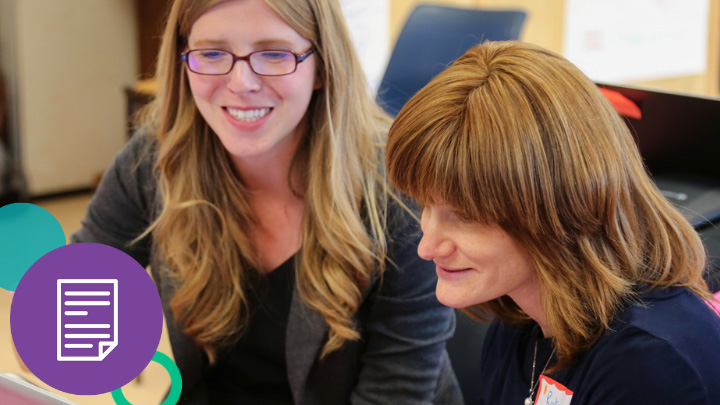Getting buy-in for a new school initiative, whether it’s opting into instructional coaching, undertaking curriculum alignment, or shifting to mastery-based grading, can be a challenge. Even if you know that the change you’re trying to make will ultimately benefit students, some degree of resistance from faculty is likely. It’s a natural part of the process. How a leader responds to the resistance will determine how successful the initiative will be. The following strategies for teacher buy-in for school initiatives will allow for productive discussions and, ultimately, support from all stakeholders.
Have One Clear Vision
Choose 1-2 goals for the year(s). Research on Massachusetts turnaround schools found the schools that did not make gains did not prioritize a couple of key areas. Instead, they focused on too many things at once (DESE). These 1-2 goals should be data-informed, high-leverage, and co-created with stakeholders. Having a clear vision leads to “higher levels of [employee] motivation, commitment, loyalty, esprit de corps, and clarity about the organization’s values, pride, and productivity,” (Manderschild & Kusy, 2005, p. 67). It’s also important to ensure performance evaluations reflect the chosen goals. If it’s a priority, make sure your feedback to teachers and evaluation of their growth reflects that priority.
Try it out! Get started with a BetterLesson strategy:
- Use the “Analyzing Student Data” protocol to identify areas for growth and make an action plan.
- Use the “Developing a Shared Vision” strategy to co-create your vision with staff.
- Revise your “Evaluative Observation” approach to align teacher evaluations with the chosen goal(s). Note: To access this strategy, you must have a BetterLesson account.
Make Space on Teachers’ Plates
As one of the most prominent experts on leading change, John Kotter, emphasizes the importance of making space for change. We can’t add to people’s plates without taking something off. If it’s a priority, something else can go.
Try it out! Get started with a BetterLesson strategy:
- Use the tips and resources in the “Common Planning Time” strategy to find time for teachers to meet regularly to work on your initiative.
Connect with Teachers’ Hearts
The prominent adaptive leadership scholar, Ronald Heifetz, says, “What people resist is not change per se, but loss,” (Heifetz, Grashow, & Linsky, 2009). With the role of teachers shifting from “sage on the stage” to “guide on the side” as we transition to personalized learning, teachers may experience a loss of identity. Empathize with and speak to the feeling of loss. Use that powerful teacher identity—help them see that their passion for helping students learn has room to flourish in the new initiative. If teachers can’t quite see this yet, listen to them. Help them discover the urgency themselves. Share existing research to add credibility to your initiative (Anderson, 2012).
Try it out! Get started with a BetterLesson strategy:
- Use the “Active Listening as an Instructional Coach” section of the “Active Listening” strategy.
- Use the “Deflecting Toxic Talk” or “How to Address Difficult Topics During a Staff Meeting” approach to the “Difficult Conversations” strategy.
Create Dissatisfaction with the Status Quo
Dannemiller’s formula for change is: change = dissatisfaction x vision x first step > resistance. This formula requires each of the following to overcome resistance: a clear vision, acceptable first steps, and a dissatisfaction with the way things are currently done. If there is no dissatisfaction, leaders must create it! Adults need a disorienting dilemma to jumpstart transformative learning (Mezirow, 1990). A disorienting dilemma forces us to examine our assumptions. Present teachers with information that makes teachers just uncomfortable enough to realize, “the way I’ve been thinking about this isn’t working anymore.” This is most effective in the context of group dialogue, as folks are able to briefly “try on” others’ ways of thinking.
Try it out! Get started with a BetterLesson strategy:
- Use the “Hot Mess” strategy to surface existing dissatisfaction and generate possible new ways of thinking that could address or re-conceptualize the dissatisfaction. Note: To access this strategy, you must have a BetterLesson account.
- Use the “GROW” or “WOOP” strategy to help teachers articulate the obstacles that make up their resistance as well as a variety of “first step” options to overcome the stated obstacles. Note: If you choose to use one of these strategies to address resistance, make sure the stated goal or wish is one the teacher and you share (e.g., an outcome for students, not the specific initiative).
All educators are in this field because we care about kids. Use that to capture teachers’ hearts, help them see how the current way of doing things is not helping kids as much as it could be, and stay focused as a leader. Stick with 1-2 goals for the year, make time for teachers to do the work, and align your feedback and evaluation with this priority(s). If you do these things, you’re much more likely to see significant progress towards your chosen goal and real results for students.







